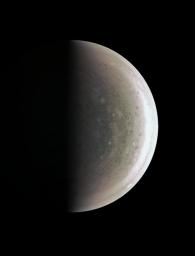
|
Jupiter Down Under
- Click the image above for a larger view
- Full-Res JPEG (1816 x 2380) (128.5 kB)
- Full-Res TIFF (1816 x 2380) (3.9 MB)
Caption:
This image from NASA's Juno spacecraft provides a never-before-seen perspective on Jupiter's south pole.
The JunoCam instrument acquired the view on August 27, 2016, when the spacecraft was about 58,700 miles (94,500 kilometers) above the polar region. At this point, the spacecraft was about an hour past its closest approach, and fine detail in the south polar region is clearly resolved.
Unlike the equatorial region's familiar structure of belts and zones, the poles are mottled by clockwise and counterclockwise rotating storms of various sizes, similar to giant versions of terrestrial hurricanes. The south pole has never been seen from this viewpoint, although the Cassini spacecraft was able to observe most of the polar region at highly oblique angles as it flew past Jupiter on its way to Saturn in 2000 (see PIA07784 ).
Background Info:
NASA's Jet Propulsion Laboratory, Pasadena, California, manages the Juno mission for the principal investigator, Scott Bolton, of Southwest Research Institute in San Antonio. The Juno mission is part of the New Frontiers Program managed at NASA's Marshall Space Flight Center in Huntsville, Alabama. Lockheed Martin Space Systems, Denver, built the spacecraft. JPL is a division of Caltech in Pasadena.
More information about Juno is online at http://www.nasa.gov/juno and http://missionjuno.swri.edu .
Cataloging Keywords:
| Name | Value | Additional Values |
|---|---|---|
| Target | Jupiter | Saturn |
| System | Jupiter | |
| Target Type | Planet | |
| Mission | Juno | Cassini-Huygens |
| Instrument Host | Juno | |
| Host Type | Orbiter | |
| Instrument | JunoCam | |
| Detector | ||
| Extra Keywords | Atmosphere, Color, Rotation, Storm, Visual | |
| Acquisition Date | ||
| Release Date | 2016-09-02 | |
| Date in Caption | 2016-08-27 | |
| Image Credit | NASA/JPL-Caltech/SwRI/MSSS | |
| Source | photojournal.jpl.nasa.gov/catalog/PIA21032 | |
| Identifier | PIA21032 | |
